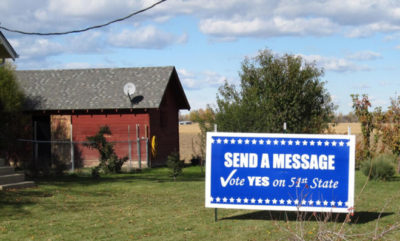 When the political world was focusing on two gubernatorial elections on election night in November, five mostly rural and agricultural counties voted to succeed from Colorado and form a 51sst state that would be named North Colorado.
When the political world was focusing on two gubernatorial elections on election night in November, five mostly rural and agricultural counties voted to succeed from Colorado and form a 51sst state that would be named North Colorado.
It further demonstrated there is a growing rural/urban divide in the United States that is going to get worse in coming years.
The secession question was not a formal initiative but instead was intended as a sort of straw poll to see if residents supported the idea of breaking away or not. The question actually was on the ballot in 11 counties and failed in six of them.
The secession movement began when Democrats took control of the legislature and began passing bills opposed by many rural voters – including gun restrictions.
The Results By County
The results of the Colorado secession movement and the divisions it exposed are as follows:
- The secession question passed by a wide margin in rural counties on Colorado’s eastern plains. For instance, 62.2 percent of voters in Phillips County on the Nebraska border voted for it. So did 59.6 percent of voters in Yuma County on the Nebraska line and 62.2 percent of voters in Cheyenne County on the Kansas state line.
- Secession failed by a large margin in more urban counties closer to Denver and Colorado Springs. For example, 57.4 percent of voters in Elbert County, which is becoming increasingly suburban, and 56.3 percent of voters in Weld County which is also becoming suburban, were against it. The closer you get to Denver, the more voters were against secession.
- The secession movement was centered on the Eastern Plains. It wasn’t on the ballot in most of Colorado including the mountains and the Western Slope. Despite some press reports, most rural counties in Colorado did not consider secession.
The Roots of Secession
The roots of Colorado’s secession movement are fairly easy to ascertain. Residents in some counties feel that they are being completely ignored by the state legislature.
“We not only want to be at the table,” Tommy Holton, the Mayor of Fort Lupton in Morgan County, which voted against secession told The Denver Post. “But we want a voice at the table as well.”
Residents of rural areas have a long list of grievances against the status quo at Colorado’s state capitol in Denver. They include:
- A state school funding system that’s critics say is so unfair to rural residents it led to a lawsuit against the state by a student in a rural high school.
- An almost complete lack of funding for rural highways, some of which are now falling apart. Meanwhile, large amounts of money are available for a massive expansion of highways and the rail transit system in the Denver area.
- Growing disputes over water, which is increasingly being diverted from agricultural uses to Denver suburbs like Aurora. Aurora’s city government has been buying water rights and drying up farmland to support development for years.
- Restrictions on oil and gas drilling and exploration.
- A mandate that would require rural electric cooperatives in Colorado to get 20 percent of their power from renewable sources by 2020. Some people believe this will lead to higher electricity costs for rural residents.
- Stricter gun control laws passed earlier this year. This included limitations on the size of magazines.
- A lack of representation at the statehouse. Eighty percent of Colorado’s residents live on the Front Range — the Fort Collins-Denver-Colorado Springs-Pueblo Corridor. The counties that voted to succeed have just two state representatives and one state senator. The Colorado State House of Representatives has 65 members and the Senate has 35 members.
“We can’t outvote the metropolitan areas anymore and the rural areas don’t have a voice anymore,” Perk Odell, who lives in Washington County, where 58.1 percent of the population voted for secession told the Associated Press. Odell’s comments are at the heart of the issue.
More Secession Movements Possible in Future
There have been other secession movements in Northern California; Southern Oregon; Pima County, Arizona; the Upper Peninsula of Michigan; and Western Maryland — none of which have landed on the ballot.
 Off The Grid News Better Ideas For Off The Grid Living
Off The Grid News Better Ideas For Off The Grid Living




